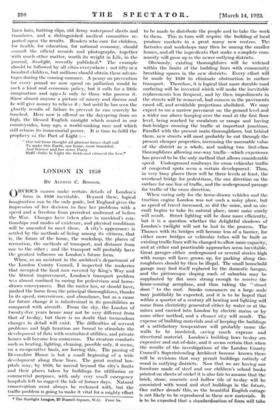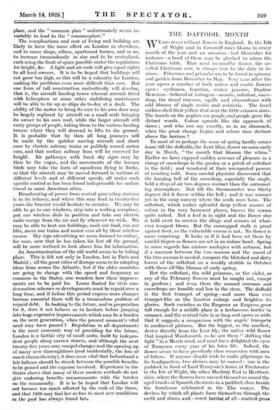LONDON IN 1950
BY ALFRED C. Bossom.
OBVIOUS causes make certain details of London's form in 1950 inevitable. Beyond these, .logiCal imagination can be the only guide, but England gives the impression of her decision to face her problems with a speed and a freedom from precedent undreamt of before the War. Changes have taken place in mankind's rela- tionships and modes of existence, and physical conditions will be amended to meet these. A city's appearanc. is settled by the methods of living among its citizens, that is, the forms of the home, the workshop, the places of recreation, the methods of transport, and distance from one to the other ; and the transport will probably have the greatest influence on London's future form.
When, as an assistant in the architect's departnient of the London County Council, I inspected the rookeries that occupied the land now covered by King's Way and the Strand improvement, London's transport problem Was almost confined to caring for pedestrians and horse- drawn conveyances. But the motor has, or should have, pushed the horse from the principal thoroughfares, thanks to its speed, convenience, and abundance, but as a cause for future change it is infinitesimal in its possibilities as compared with aircraft. From the sky, the London of twenty-five years hence may not be very different from that of to-day, but there is no doubt that tremendous changes in detail will exist. The difficulties of servant problems and high taxation are bound to stimulate the development of flats with centralized utilities, and private homes will become less numerous. The creature comforts such as heating, lighting, cleaning, possible only, it seems, on a co-operative basis, are forcing this. The passing of Devonshire House is but a small beginning of a wide development along these lines. The great central hos- pitals may, by 1950, be moved beyond the city's limits and their places taken by buildings for utilitarian or commercial purposes, with only very small emergency hospitals left to suggest the tale of former days. Natural conservatism must always be reckoned with, but the traffic probleni is going to make it vital for a mighty effort
* The Sunlight League, 37 Russell Square, W.C. Price Is.
to be made to distribute the people and to take the work to them. This in turn will- require the building of local produce markets in a great many new centres. The factories and workshops may then be among the smaller homes, and all the ingredients that make a complete com- munity will grow up in the newer outlying districts.
Obviously, existing thoroughfares will be widened within the limits of the building lines with community breathing spaces in the new districts. Every effort will be made by 1950 to eliininate obstruction in surface transport. Therefore, it is logical that more durable road - surfacing will be invented which will make the inevitable replacements less frequent, and by then impediments in the streets will be removed, bad corners in the pavements eased off, and avoidable projections abolished. We may expect to see a narrow pavement on the ground level and a wider one above hanging over the road at the first floor level, being reached by escalators or ramps and having foot-bridges crossing the traffic at important junctions.
Parallel with the present main thoroughfares, but behind them, new streets will most probably be cut through the present cheaper properties, increasing the assessable value of the district as a whole, and making two first-class thoroughfares allowing one-way traffic—which experience has proved to be the onlkinithod-that allows considerable speed. Underground roadways for cross vehicular traffic - at congested spots seem a certain development. Thus, in very busy places there will be three levels at least, the overhead bridge for pedestrians, the one direction on the surface for one line of traffic, and the underground passage for traffic of the cross direction.
When caring only for the horse-drawn vehicles and the traction engine London was not such a noisy place, but as speed of travel increased, so did the noise, and as air- craft begins to take its natural'place; more noise surely will result. Street lighting will be done more efficiently, but it is a question whether the delightful shadows of London's twilight will not be lost in the process. The Thames with its bridges will become less of a barrier, for either more bridges or vehicular tubes will be built or existing-traffic lines will be changed to alldw More capacity; and at either end practicable approaches seem inevitable.
Great garages either underground or several stories high with ramps will have grown up, for parking along tho- roughfares should by .then be illegal. The small household garage may find itself replaced by the domestic hangar, and the picturesque sloping roofs of suburbia may be supplanted by flat ones strong enough to receive the home-coming aeroplane, and thus taking the " street door " to the roof. Smoke consumers on a large scale may justifiably be expected, and it is to be hoped that within a quarter of a century all heating and lighting will come from electricity generated either by water or at the mines and carried into London by electric mains or by some other method, and a cleaner city will result. The expense of building materials and of keeping the buildings at a satisfactory temperature will probably cause the walls to be insulated, saving much expense and structural material. London's building laws to-day are expensive and out-of-date, and it seems certain that when the results of the investigations of the London County Council's Superintending Architect become known there will be revisions that may permit buildings entirely of wood in outlying districts. Now that we are having our furniture made of steel and our children's school books printed on sheets of nickel it is also fair to assume that the brick, stone, concrete and hollow tile -of to-day will be associated with wood and steel buildings in the future. One rather dreads this, as the beautiful English cottage is not likely to be reproduced in these new materials. It is to be expected that a standardization of form will take place, and the " common plan " unfortunately seems in- vatiably to. lead to the " commonplace."
The complications and cost of living and building are likely to have the same effect on London as elsewhere, and to cause shops, offices, apartment houses, and so on, to increase tremendously in size and to be centralized, each using the limit of space possible under the regulations . for height, &c. A light and air code, will give equal rights to all land owners. , It is to be hoped that buildings will not .grow too high,_ as this will be a calamity for London, making the problems even more difficult than now. But one form of tall construction undoubtedly will develop, that is, the aircraft landing tower whereat aircraft fitted with helicopters or some other stabilizing contrivance will be able to tie up as ships do to-day at a_ dock. The ability of the motor to bring its user to his own door may be largely replaced by aircraft on a small scale bringing its owner to his own roof, while _the larger aircraft will carry groups of people, taking them to the various landing towers where they will descend in lifts to the . ground. It is probable that . by then all long journeys will be made by the quicker moving aircraft and short ,ones , by electric subway, trains or publicly owned motor cars, and that surface railway lines will_ be reserved for freight. Air pathways . with fixed sky signs may by then be the vogue, and the movements of the human birds may take the form of squadrons flying in flocks, _so that the aircraft may be moved forward in sections at different levels and at different speeds, all under. such .specific control as has been found indispensable for surface travel -in some American cities.
Broadcasting of power from central generating stations is in its infancy, and where this may lead in twenty-five years the bravest would hesitate to surmise. We may be able to go to our windows, step into a waiting aeroplane, put our wireless dials in position and take our electric -radio-energy from the air and fly wherever we wish. We may be able to heat our buildings, cook our food, run our lifts, move our trains and motor cars all by these wireless :Means. Sky sign advertising we seem doomed to endure, for man, now that he has taken his feet off the ground, will be more inclined to look above him for information.
An Americanization of the old world seems to be taking place. This is felt not only in London, but in Paris and Madrid; all the great cities of Europe seem to be adopting ideas from across the Atlantic, but if the older countries are going to change with _the speed and frequency so common in the States, one.eswonders how these improve- ments are to be paid for. Loans floated for civic con- demnation scheines or developments must be repaid over a long time, and if before this period expires more changes becorae essential there will be a tremendous problem of unpaid debt. In looking to the future, and in preparation for it, does it not behove us to hesitate before jumping into huge expensive improvements which may be a burden on the next generation, when the present moment's vital need may have passed ? Regulation in all departments is the most economic way of providing for the future, London is a Gothic city, of small units, built by indepen- dent people along narrow streets, and although the next twenty-five years may compel changes and the opening up of many new thoroughfares (and incidentally, the loss of much charm thereby), it does seem vital that beforehand a fair balance should be struck between the possible benefits to be:gained and the expense involved. Experience in the. States shows that many of these modem methods do not give enduring benefits commensurate with the burden on the community. It is to be hoped that London -will not become .too much. affected by the rush of the times, and that 1950 may find her as free to meet new conditions as-the past has ,always found her.















































 Previous page
Previous page